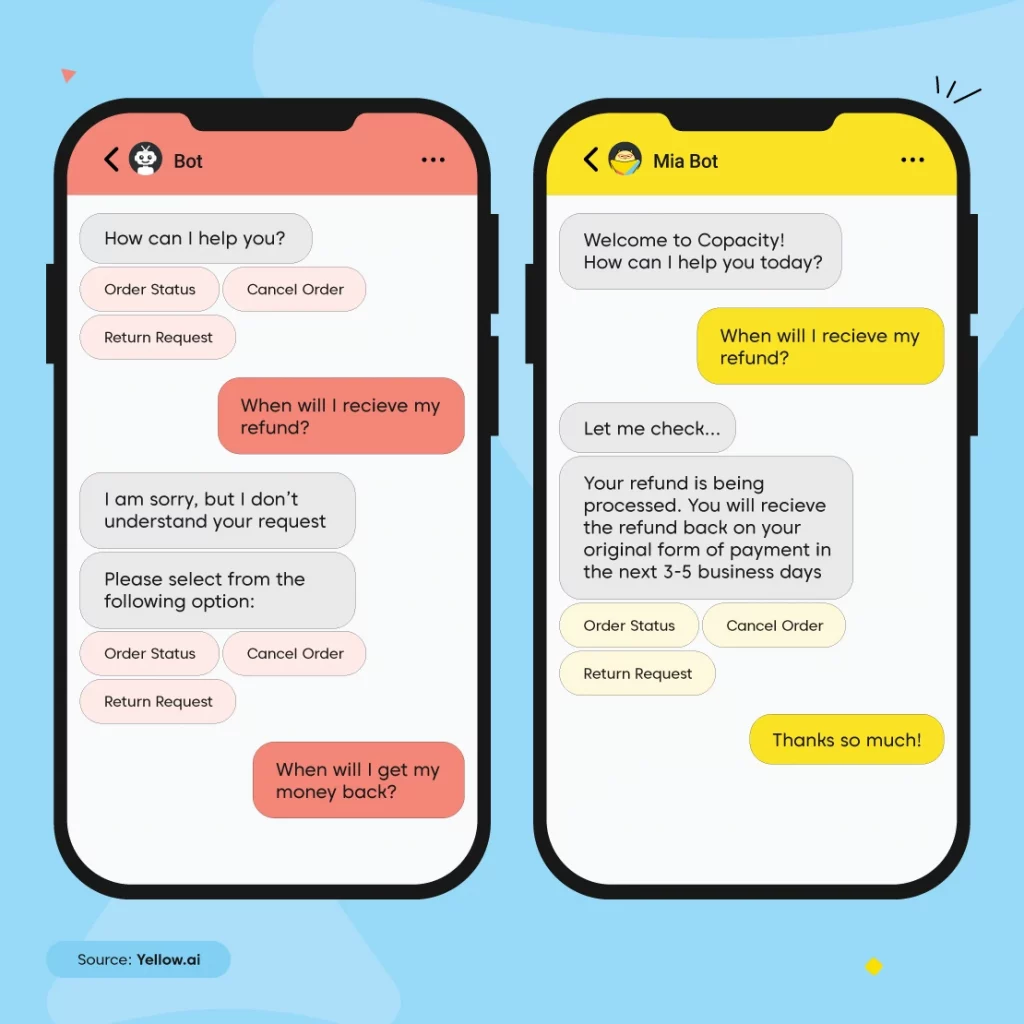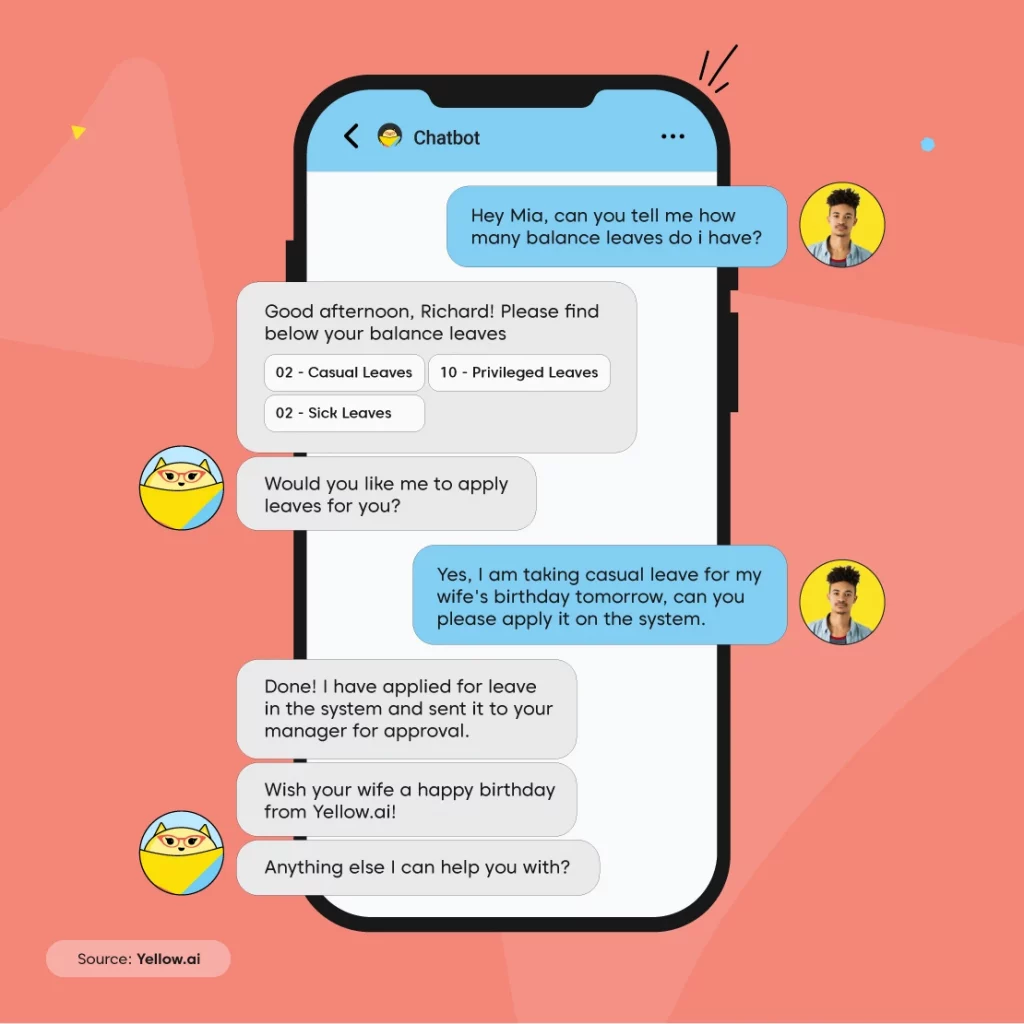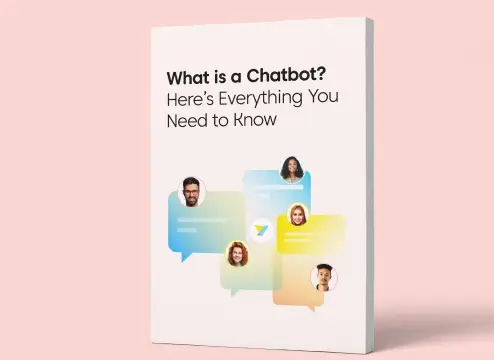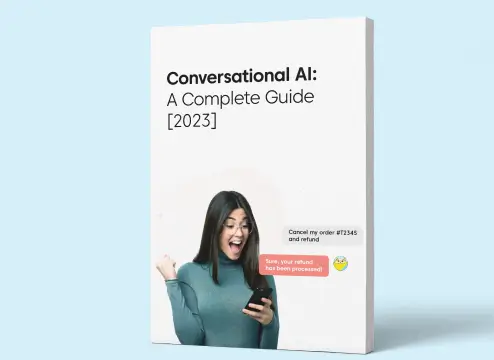We get asked almost everyday if there is any notable difference between chatbots and conversational AI. Both these terms are used interchangeably quite often, which is valid up to some extent. However, on the whole, their differences are striking and even more crucial in a business setting. To accurately differentiate between chatbots and conversational AI, we must first unpack the hype around them, and start from the very basics.
What are chatbots?
Chatbots are software applications that are designed to simulate human-like conversations with users through text. They use natural language processing to understand an incoming query and respond accordingly. Most chatbots are rule-based, which means they are trained to answer only a specific set of questions, mostly FAQs, which is basically what makes them distinct from conversational AI.
Businesses worldwide are increasingly deploying chatbots to automate user support across channels. However, a typical source of dissatisfaction for people who interact with bots is that they do not always understand the context of conversations. Infact, according to a report by Search Engine Journal, 43% of customers believe that chatbots need to improve their accuracy in understanding what users are asking or looking for.
On the other hand, because traditional, rule-based bots lack the contextual sophistication, they deflect most conversations to a human agent. This will not only increase the burden of unresolved queries on your human agents but also nullify the primary objective of deploying a bot.

What is Conversational AI?
Conversational AI integrates artificial intelligence, natural language processing and machine learning to make traditional bots smarter and capable of having more human-like conversations. Conversational AI agents get more efficient at spotting patterns and making recommendations over time, as you build up a larger corpus of user inputs.
According to an MIT Technology Review report, more than 90% of businesses reported that they had seen significant improvements in complaint resolution, call processing, customer and employee satisfaction with conversational AI chatbots.
Conversational AI is enabling businesses to deliver more personal experiences to their users by having more fluid and intelligent conversations. Artificial intelligence, with its capabilities of comprehending natural language, active learning, dialogue flow management and data mining, helps transform and automate end-to-end user journeys.
Chatbots vs Conversational AI
According to what we’ve learnt so far, chatbots require conversational AI technology to become smarter and more powerful. It is important to note, however, that not all chatbots use conversational AI.
Traditional chatbots are only capable of doing a limited number of functions. In most cases, this entails answering basic FAQs. Conversational AI improves the chatbot’s ability to better interpret human language and deliver more personalized, two-way user interactions in order to meet the rising expectations of modern customers.

Which solution is better suited for your business?
There is really no right answer to this question. While conversational AI is almost always the better choice for your company, it also depends on your individual goals and requirements. If you are just looking for a bot to answer simple FAQs on your website, then you can definitely go for a traditional chatbot. However, if you are looking to improve user satisfaction, increase engagement, reduce the workload on human agents by automating support across multiple platforms using both text and voice, then conversational AI is the right choice.
Conversational AI agents can help automate up to 80% of query resolution with little to no human intervention. Let’s look at how conversational AI might benefit your business more than a traditional chatbot.
5 Benefits of Conversational AI over traditional chatbots
1. Advanced natural language understanding
Traditional chatbots are built on logic rules and deliver answers based on the keywords that are already incorporated or written in the system. Chatbots won’t answer questions that aren’t within their algorithmic parameters.
While conversational AI is built on natural language processing and response. A question is responded using multiple technologies including machine learning, deep learning and predictive analytics that offer a human touch. Because of this, AI learns on its own and reacts accordingly depending on past inquiries and searches.
2. Contextual maturity
There is only so much information a rule-based bot can provide to the customer. If they receive a request that is not previously fed into their systems, they will be unable to provide the right answer which can be a major cause of dissatisfaction among customers.
Conversational AI, on the other hand, focuses on the prior discussions, chats, enquiries, transactions, and history of the consumer and, based on the same, makes tailored suggestions. The contextual awareness makes the customer even more satisfied and loyal. In fact, research suggests that 56% of customers stay loyal to brands which “get them.”

3. Multi-intent cognition
There is no one-size-fits-all answer to all questions. For example, if a customer wants to know if their order has been shipped as well how long it will take to deliver their particular order. A rule-based bot may only answer one of those questions and the customer will have to repeat themselves again. This might irritate the customer, as they didn’t get the info they were looking for, the first time.
On the contrary, conversational AI platforms can answer requests containing numerous questions and switch from topic to topic in between the dialogue. Because the user does not have to repeat their question or query, they are bound to be more satisfied.
4. Integration, scalability, accuracy and consistency
Chatbots, although they are cost-efficient, are scattered and disconnected. They are independently incorporated into numerous systems; scalability and uniformity are mostly lacking. Once the platform is switched, the whole inquiry needs to be initiated again, hindering efficiency.
Conversational AI solutions offer consistency in quality, scalability in terms of queries that it can manage and integration in multiple social media platforms. In other words, conversational AI enables an omnichannel presence at scale. As a result, customers have a better overall experience.
5. Multilingual capabilities and voice assistance
When compared to conversational AI, chatbots lack features like multilingual and voice help capabilities. The users on such platforms do not have the facility to deliver voice commands or ask a query in any language other than the one registered in the system.
Siri, Google Assistant and Alexa all are the finest examples of conversational AI technologies. They can understand commands given in a variety of languages via voice mode, making communication between users and getting a response much easier.
How to get started with Conversational AI?
There is a common misconception that building conversational AI solutions is both expensive and time-consuming. While it can be true if you build a solution from ground-up by hiring specialized developers, it is not necessary.
With the right solution, you can build customized AI-powered bots. There is no need to hire developers and spend time building a solution from scratch. Next-gen conversational AI platforms such as Yellow.ai enable you to build and deploy AI-powered chatbots in just a few clicks using pre-built templates for your specific industry and use-case, without writing a single line of code. Don’t believe me, try for yourself!
Sign up for a free trial of our enterprise-grade conversational AI platform and get to market at lightning speed.

















